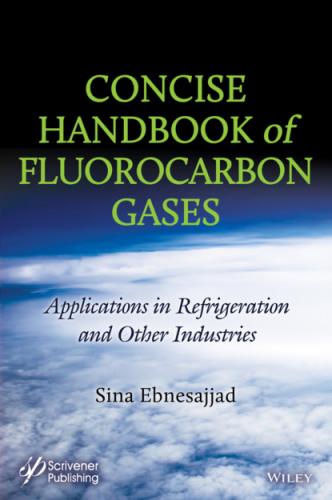Carbon and fluorine form one of the strongest covalent bonds with an average bond energy around 480 kJ/mol. It exceeds the strength of carbon bond with other halogens (Table 3.2). C-F strength is one of the important reasons for high thermal and chemical stability of organic fluorochemicals. The F atoms have just the right size to create a protective shield (or sheath) over the carbon backbone when it is attached directly to the chain like in polytetrafluoroethylene (PTFE). If the F atoms were any smaller or larger than they are, the sheath would not form a regular uniform cove. This F shield protects the carbon chain from attack and confers chemical inertness and stability to PTFE. Fluorinated chemical groups play a similar role in hydrocarbons [5].
Table 3.1 Atomic properties of fluorine and other elements [4].
| Element | Van der Waals, radii, nm | Electronegativity, Pauling |
| F | 0.147 | 3.98 |
| O | 0.152 | 3.44 |
| N | 0.155 | 3.04 |
| C | 0.170 | 2.55 |
| H | 0.120 | 2.20 |
Table 3.2 Atomic properties of fluorine and other elements [4].
| Element | Average bond strength, kJ/mol | Average bond length, nm |
| C-F | 485 | 0.139 |
| C-C | 356 | 0.153 |
| C-O | 336 | 0.143 |
| C-H | 416 | 0.109 |
3.2 Fluorine Sources
Fluorine is the 13th most common element on the Earth but it occurs virtually only as inorganic compounds. There are three industrially significant fluorine minerals: fluorite or fluorspar, fluorapatite and cryolite. Fluorspar consists of CaF2, seen in Figure 3.1 and comes in two grades. The more pure variety is called acid grade and is used for HF production. The other fluorspar grade (lower) is used in metallurgy in iron and steel casting, primary aluminum production, glass manufacture, enamels; welding rod coatings, cement production, as a flux in steelmaking and in other applications [6].
Fluorapatite or fluoroapatite is a phosphate with the chemical formula of Ca5(PO4)3F [Figure 3.1(b)]. It is the most abundant fluorine ore but it contains little fluorine. The third fluorine mineral Cryolite [Figure 3.1(c)] has a chemical formula of Na3AlF6, used in aluminum production. Cryolite has the highest amount of fluorine but it is a relatively scarce ore.
The dynamics of supply and consumption of fluorspar are quite complex. Fluorspar price and annual consumption/import for the United States is presented in the rest of this section. Figure 3.2 is helpful in clarification of some of the issues relevant to fluorspar. Some of the factors impacting the imported quantities and the prices are listed below:
1 The general economy and business cycle such as recessions and booms.
2 Demand for fluorinated and other materials that requiring HF.
3 United State stopped production of fluorspar after 1996.
4 USA has been importing acid grade fluorspar mostly from China, Mexico and South Africa. These three countries are the major three producers of CaF2 in the world.
5 During the early years post stoppage of domestic fluorspar China was the primary supplier to the US. In the recent years Mexico is the top supplier.
6 A supply of fluorspar is maintained by the Defense National Stockpile Center. The Center sells the fluorspar as required.
7 The Montreal Protocol (1987) banned most chlorofluorocarbon (CFC) gases. A two-phase replacement plan was developed: 1. To transition from CFCs to Hydrochlorofluorocarbons (HCFCs) as an intermediate solution; 2. To replace HCFCs with Hydrofluorocarbons (HFCs) and 3. To replace all previous fluorocarbons with low Ozone Depleting and low Global Warming replacements such as hydrofluoroolefins.
8 Most CFCs were phased out by 1996; the rest were removed by 2010; HCFCs replaced CFCs. The replacement required a one-time large block of production to replace all fluids in refrigeration and air conditioning units in addition to other applications of CFCs.
9 European Union countries replaced all HCFCs with HFCs by the end of 2010.
10 In 2010 the Chinese Ministry of land and Resources placed a quota on the annual production rate of fluorspar limiting at 11 million tons.
11 In the recent years many programs have been implemented to capture and recycle fluorocarbons in addition to reducing consumption of these materials.
12 Some of the fluoropolymer manufacturing, specifically polytetrafluoroethylene, has moved away from the US, to China and India.
13 A reason fluorinated chemicals are more expensive than hydrocarbons is the cost of fluorspar.
Figure 3.1 Photographs of fluorine minerals: (a) fluorspar, (b) fluorapatite, and (c) cryolite Sources: (a) www.themineralgallery.com/elmwoodroom.htm, Courtesy: www.mindat.org and the Hudson Institute of Mineralogy (b) www.mindat.org/photo-16871.html, Courtesy: David Soler, (c) www.mindat.org/min-1161.html, Courtesy: JGW, May 2016.
Figure 3.2 Historical US imports and prices of acid grade fluorspar [7].
As shown in Figure 3.3, China mines more acid-grade fluorspar than any other country in the world, at 2,500 ktons annually. Mexico is the second-largest producer of acid-grade fluorspar at around 600 ktons annually, followed by South Africa (150 ktons). Contributions from the rest of the world have declined since the mid-2000s, with the remaining balance of acid-grade fluorspar production at about 300 ktons in 2016 [7].
From the mid-1990s to early 2000s, most of the acid-grade fluorspar mined in China was exported to the major refrigerant producing regions (US, EU, Japan). Starting from around 78% in 1999,
